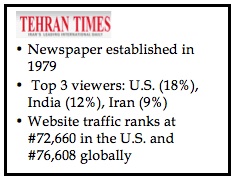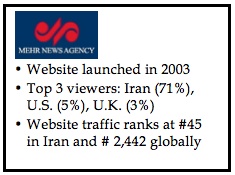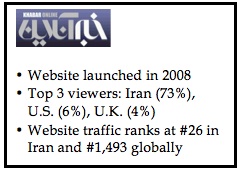Helia Ighani and Garrett Nada
Since 2007, Iran’s English-language media has increasingly become its chief propaganda tool. The turning point was the launch of Press TV, a news website and international television station that seeks to compete with the world’s most sophisticated media. Press TV even hired non-Iranian correspondents on five continents to widen its coverage – and, in principle, its credibility. The station frequently interviews American and other Western experts on its news and talk shows.
Iran’s English-language media predates the 1979 revolution. Major Iranian papers published English dailies starting in the 1950s. They published original content on domestic news, stories from Western wire services, and op-eds from other papers.
The English-language media became generally anti-Western after the 1979 revolution. Yet it now tends to be obsessed with American problems, from economic challenges like the “fiscal cliff” to foreign policy hurdles in Afghanistan. Several agencies covered the Occupy Wall Street protests in 2011 and 2012. They also devote space to American crime stories and scandals, such as the affair that triggered the resignation of CIA Director David Petraeus.
The English-language media focuses on news from Middle Eastern, Muslim and developing countries, notably China and India. It also highlights Iranian cultural and religious influence among Shiite communities in Lebanon, Iraq and the Gulf. Domestic coverage is limited largely to political, economic and cultural news that reflects well on the regime.
The English-language media differs significantly from its Farsi counterpart. Fars News, which is one of Iran’s largest news agencies, rarely mentions internal political tensions on its English website. It generally highlights Tehran’s leadership role in the Middle East, such as aid to the government of President Bashar Assad to quash the uprising. Fars describes Syrian rebels as “terrorists.”
But the agency’s Farsi-language wire service is consumed with political infighting and economic mismanagement. It routinely blames President Mahmoud Ahmadinejad for the failing economy. It cites his combative language for compounding Western sanctions.
Iran’s English-language media is largely conservative politically. Some outlets are state-controlled, while others are independent. But Iran’s English media lacks a strong reformist voice. The following profiles of the 11 most prominent news agencies that publish in English are based on information from their websites and open sources.
Press TV
Iran’s most polished English-language news agency is Press TV. Press TV established its website in January 2007 to offer “an alternative perspective on world events.” It was the first Iranian international news network. It is both a 24-hour satellite channel and a website modeled on global outlets such as CNN, al Jazeera and the BBC. Press TV basically provides an Iranian perspective on global issues for English speakers. Its online mission statement describes its goal as “heeding the often neglected voices and perspectives of a great portion of the world.”
Press TV differs from other Iranian English-language media websites because it employs many non-Iranian contributors. Its anchors speak fluent English, often with British accents. Press TV reportedly operates in the United States through small companies or freelance journalists.
In October 2012, the French-owned Eutelsat stopped hosting Iranian television stations, including Press TV, to comply with European Union sanctions. The United States also banned the satellite broadcast of Press TV in February 2013, in compliance with sanctions on the Islamic Republic of Iran Broadcasting. But viewers can still access the live broadcast through Press TV’s website or mobile application.
Press TV’s CEO, Mohammad Sarafraz, is also the deputy head of the Islamic Republic of Iran’s Broadcasting – Iran’s official radio and television organization.
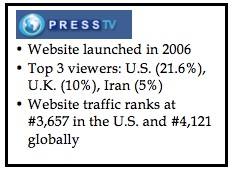 Press TV website
Press TV website
YouTube page
Facebook page
Twitter feed
Ettelaat (or “Information”)
Ettelaat, which began publishing in 1926, is Iran’s oldest newspaper. It claims to be “the only international daily newspaper in Farsi.” From 1954 to 1978, Ettelaat published an English paper called Tehran Journal. The coverage was rarely critical of the government. During the monarchy, Ettelaat was hostile to the clerical opposition. In January 1978, Ettelaat published a controversial article saying that Ayatollah Khomeini was a British spy and a homosexual. In the build-up to the Islamic Revolution, the article sparked widespread protests in the holy city of Qom that resulted in the deaths of at least eight individuals.
After the 1979 revolution, the new government purged Ettelaat’s staff and appointed Hojatoeslam Seyed Mahmoud Doaie as editor-in-chief. He still heads the paper, which now features an English page in its Farsi daily. Ettelaat also has an English website, which often reports on Tehran’s role in the Syrian conflict, economic advancements and trade relations with other countries. Ettelaat’s website also publishes electronic copies of its print newspaper.
IRNA (Islamic Republic News Agency)
Iran’s foreign ministry established the news service in 1934 under the name Pars Agency. By the 1950s, Pars had agreements with Western news wires like Agence France Press, the Associated Press and Reuters. After the 1979 revolution, the new government changed its name to the Islamic Republic News Agency. IRNA became Iran’s official news agency under the Ministry of Culture and Islamic Guidance.
IRNA launched its website in December 1996. The English-language page provides extensive coverage of international and domestic news. IRNA also publishes several papers and other periodicals, including The Iran Daily. The English-language paper covers both domestic and international news. As of 2011, IRNA had 60 domestic offices and 30 bureaus outside Iran.
From 2010 to 2012, IRNA’s managing director was Ali Akbar Javanfekr. But in September 2012, Javanfekr was arrested for publishing material that was considered insulting to Supreme Leader Ayatollah Ali Khamenei. Javanfekr was also President Ahmadinejad’s press advisor. In January 2013, Majid Amidi Sharaki replaced Javanfekr.
Kayhan (or “Universe”)
Founded in February 1943, Kayhan was considered pro-monarchy before the revolution.
In 1959, the paper began publishing an English-language paper, Kayhan International. Kayhan International was separate from its Farsi counterpart. For two decades, it was one of the leading English papers in the Middle East. Foreigners living in Iran read its extensive coverage of domestic developments. Kayhan International had more features and was more independent than Ettelaat's Tehran Journal, another English-language paper.
The new Islamic government seized ownership of Kayhan and its affiliates in 1979 and put them under the Office of the Supreme Leader’s supervision. The majority of the staff was fired. Kayhan then became a hard-line paper. Masoumeh Ebtekar —spokeswoman for the students during the 1979 hostage crisis— reportedly became editor-in-chief of Kayhan International in 1981 and headed the paper until 1983.
Kayhan’s current editor-in-chief, Hossein Shariatmadari, is reportedly a close confidant of the Supreme Leader. Kayhan International now publishes short stories from Western wire services or other Iranian agencies on its website. It is regularly updated but has less content and fewer features than Press TV, Fars and others.
ISNA (Iranian Students News Agency)
University students in Tehran founded ISNA in 1999, a time when the student movement was particularly vibrant and reformist. Its coverage gradually expanded beyond university events and student issues to include domestic and international topics. Many of its correspondents are still student volunteers. ISNA’s chief-of-staff, Ali Motaghian, is also the general manager of the president’s office of Communication Information, Scientific Research, and Technology.
ISNA, which emerged during the presidency of Mohammad Khatami, still has reformist leanings. It is widely considered to be more independent than other agencies.
Fars News Agency
Fars News Agency is a wire service that is reportedly tied to the Revolutionary Guards. Its managing director is Saeed Noubari, the former chief of public relations of the Tehran Justice Department. The editor-in-chief, Abbas Darvish Tavangar, also heads the Association of Iranian Journalists and Reporters.
Its English-language service was launched in 2006 and publishes different content than the Farsi-language website. Fars occasionally interviews Westerners, but its commentators are primarily Iranian.
ABNA (Ahlul Bayt News Agency, or “People of the House”)
ABNA was launched in March 2005 to cover worldwide Shiite news, unlike other Iranian news agencies that do not have an explicit religious focus. ABNA does not publish a print newspaper. Its website publishes articles on Iran’s Shiites and the role of the Supreme Leader. But it also covers Shiite communities in other parts of the world. ABNA publishes in more than a dozen languages, including Swahili, Chinese, and Bosnian.
Jam-e Jam (or “Cup of Life”)
Jam-e Jam is an official publication of the Islamic Republic of Iran Broadcasting. Its Farsi daily has one of the widest circulations in Iran. Jam-e Jam launched its website in October 2002 as “the first Iranian cyber newspaper.” The English-language site covers domestic and international issues. Bijan Moghaddam is the current managing director.
Tehran Times
Iran’s first English daily newspaper was established in 1979. Chairman of the Assembly of Experts Ayatollah Mohammad Beheshti intended it to be “a loud voice of the Islamic revolution and the loudspeaker of the oppressed people of the world.” He was assassinated in 1981. Hamid Golpira is Tehran Times’ current senior editor.
Mehr News Agency (or “Kindness”)
The Islamic Ideology Dissemination Organization established Mehr in 2003 as a Farsi and English-language news service affiliated with The Tehran Times. Over the last decade, Mehr has hired correspondents in Asia, Europe, the Middle East and South America. It now publishes in Arabic, Turkish, Urdu and German. Mehr has reportedly partnered with over a dozen foreign news agencies to expand its coverage of world events. Mehr’s CEO and managing director is Reza Moghadasi.
Khabar Online (or “News Online”)
Launched in 2008, Khabar claims to be the third most visited Iranian news site. Khabar’s Facebook page says it is moderately conservative. Khabar publishes articles on Iran’s politics, culture and economy. The website’s expansive cultural section publishes articles on the local film industry. Its chairman is Hossein Entezolmi and its managing director is Alireza Mazi.
Helia Ighani is a graduate student at George Washington University's Elliott School of International Affairs and a research assistant at the Woodrow Wilson International Center for Scholars.
Garrett Nada is a Program Assistant in the Center for Conflict Management at the United States Institute of Peace.
* Internet statistics by alexa.com
Online news media are welcome to republish original blog postings from this website in full, with a citation and link back to The Iran Primer website (www.iranprimer.com) as the original source. Any edits must be authorized by the author. Permission to reprint excerpts from The Iran Primer book should be directed to permissions@usip.org

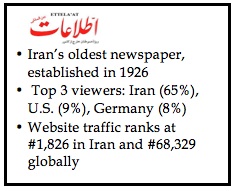 Ettelaat website
Ettelaat website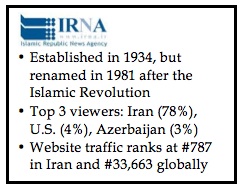 IRNA website
IRNA website 
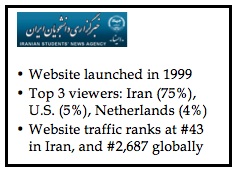
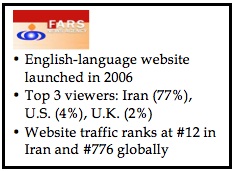
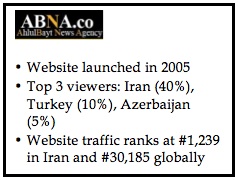
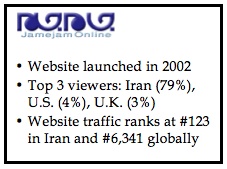 Jam-e-Jam website
Jam-e-Jam website